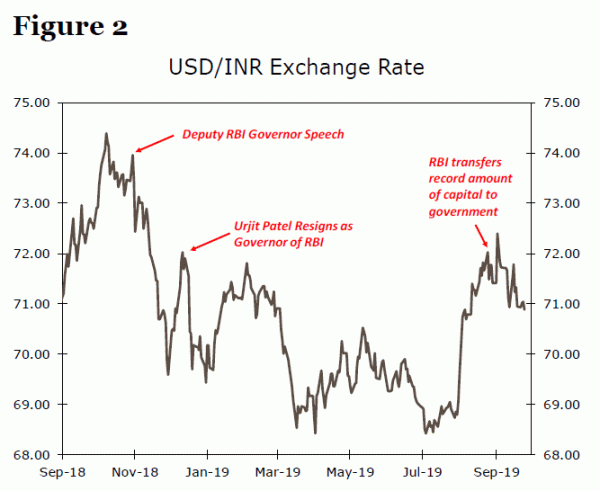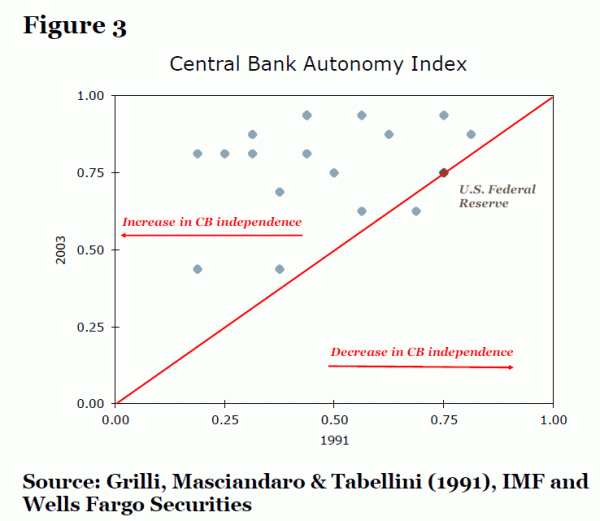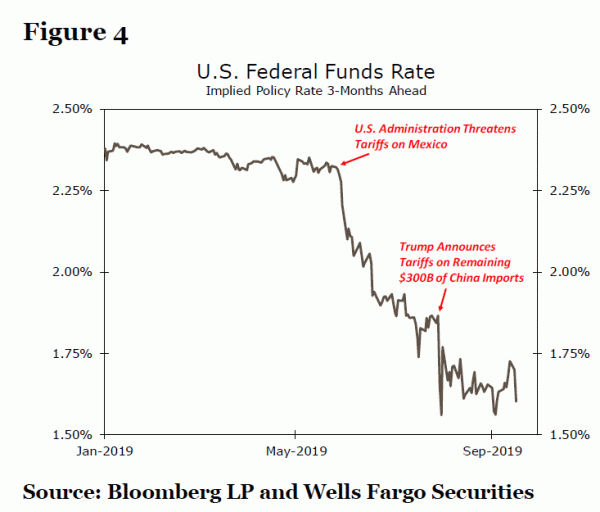Executive Summary
- One of the more important characteristics a central bank needs to maintain is its credibility. An erosion of central bank credibility—and in turn independence—has typically been associated with a sharp currency depreciation, as evidenced in Turkey and India.
- In our view, political pressure on the Fed has some potential to erode central bank independence in the United States. Although we do not believe the Fed is responding directly to political pressures, politics could potentially have an indirect influence over the Fed’s monetary policy decisions through market volatility.
- The U.S. administration’s stance on trade policy is also beginning to influence monetary policy, with Fed Chair Powell citing trade developments as an influence into monetary policy decisions.
- A combination of political and policy pressures could maintain or even increase market volatility, which has the potential to result in more aggressive Fed easing and a weaker U.S. dollar.
Political Pressure and Eroding Central Bank Independence
One of the most important characteristics for central banks is the need to maintain credibility. A credible central bank is typically viewed as an institution capable of managing an economic crisis, able to contain inflation and provide stability to a country’s exchange rate. Historically, central banks that have been more susceptible to political pressures have had challenges developing and preserving credibility. Once markets lose confidence in a central bank’s credibility and witness a decrease in the independence of the central bank, a sharp sell-off in the currency could ensue.
This has been most evident in Turkey, where President Erdogan has continued to exert pressure on the central bank and attempted to influence monetary policy. A decrease in central bank independence was one of the key contributing factors to the lira’s large selloff in 2018. Last year, a string of developments challenged the independence of the central bank, including President Erdogan publically stating that he was taking more control of monetary policy, a speech in which Erdogan strongly indicated the central bank would not raise rates, as well as appointing his sonin- law as finance minister. In addition, some key central bank officials resigned as concerns regarding the government’s interference in monetary policy continued to build.
In just the past few months, Erdogan has also replaced the governor of the central bank with an appointee more willing to implement his views on monetary policy, while also publically stating that the central bank would ease monetary policy in September before the central bank took action. Erdogan’s actions have eroded the independence of the Turkish central bank, while the credibility of the Turkish central bank has deteriorated over time and has kept the currency under pressure for most of this year.
The Reserve Bank of India (RBI) is another example of a central bank in a developing economy that has come under political pressures. These political influences became apparent in October 2018, when the deputy governor of the RBI, Viral Acharya, gave a speech highlighting the possible effect on India’s currency and financial markets if the independence of the RBI was undermined. While Acharya’s comments themselves did not result in a large selloff of the rupee, the resignation of RBI Governor Urjit Patel in December of last year did have a pronounced effect on the currency, with the rupee depreciating more than 2% during the day. Patel shared the same independence concerns as Acharya, and left the RBI when PM Modi increased pressure on the central bank to transfer its cash reserves to the government to support the economy through additional fiscal spending. Concerns have intensified over the past few weeks as the RBI transferred a record amount of excess cash to the government. In our view, the amount of the RBI’s cash transfer to the government could be an indicator that central bank’s independence is fading.
Political Pressure on the Fed is Building…
Studies have suggested that major central banks have become more independent over time.1 A study in 1991 by three economists—Grilli, Masciandro, and Tabellini—and refreshed by the IMF in 2003, suggests that most foreign central banks have strengthened their political and economic autonomy. Political autonomy is defined as the ability of the central bank to select its final monetary policy objectives, while economic autonomy is a measure of independence that the central bank has when selecting its tools to implement monetary policy. The combination of political and economic autonomy generates the central bank autonomy index, an indication of how independent a central bank is. As the chart indicates, all major central banks have become more independent over time with the exception of one, while the Fed has held steady. In this framework, Fed independence has been broadly stable; however, we acknowledge this analysis was last updated in 2003.
The central bank autonomy index does not point to an increase in Fed independence, and very recent developments arguably have the potential to see a decrease in the independence of the Fed over time. Over the past year, some members of the Trump administration have questioned the Fed’s monetary policy decisions. For example, President Trump has stated on multiple occasions that he would prefer the Fed ease monetary policy meaningfully to stimulate the U.S. economy and weaken the U.S. dollar. In addition, the president reportedly explored the legality of removing Fed Chairman Powell. The regular attacks on the Fed and Jerome Powell have led many market participants to at least question whether the independence of the Fed is now more uncertain.
The perceived independence of the Fed is arguably just as important as its actual independence. To the extent that the administration’s pressure on the central bank creates questions or uncertainties surrounding the policy actions of the Federal Open Market Committee (FOMC), it has the potential to, at least in the public’s eyes, affect the perceived credibility of the Federal Reserve. Any actions that effect the perceived authority, confidence or credibility of the Fed, would likely create challenges for the Federal Reserve to effectively meet its inflation and employment objectives, and make the independence of the central bank more uncertain as well.
While the political pressure from the U.S. administration presents a new challenge for the Fed, we do not believe the FOMC is directly responding to attempts to influence monetary policy. Just as importantly, however, there may be some indirect effects on monetary policy as a result of the volatility in financial markets that political pressures may have created. This view is largely based on our interpretation of the Fed’s reaction function, such that more recently, the FOMC is placing a bit more weight on global developments and financial markets, and a bit less weight on domestic economic data.
Political pressure on the Fed can potentially result in markets pricing in more aggressive easing from the FOMC. As a result of our view on the Fed’s reaction function, there is a possibility the administration’s attempts may indirectly cause the FOMC to ease monetary policy more aggressively than we currently expect. If the administration continues its efforts to influence monetary policy, then financial markets could be moderately disrupted.
…While Trade Policy Is Affecting Monetary Policy
In addition to putting pressure on the Fed, the administration’s stance on U.S. trade policy could also have a potential effect on U.S. monetary policy. In multiple press conferences and speeches, Fed Chair Powell has cited often uncertainty over U.S. trade policy as a primary risk to the global economic outlook. More specifically, Powell indicated that trade tensions with China were an influence on the FOMC’s decisions to reduce interest rates 25 bps in July and another 25 bps in September. Although it is unlikely the administration is escalating trade tensions to place pressure on the Fed to cut rates, trade tensions are clouding the economic outlook and have led to increased volatility in financial markets. Escalated trade tensions tend to increase uncertainty and market volatility, with market volatility typically being complemented by markets pricing in more aggressive interest rate cuts from the Fed.
For example, in May of this year, a threat to impose tariffs on imports from Mexico resulted in markets immediately pricing in an additional 11 bps of Fed easing over the next few days. The risk of tariffs on Mexico’s exports to the U.S. lingered over markets for a relatively short time; but, even the threat of new tariffs increased uncertainty surrounding U.S. trade policy, further contributing to markets pricing in additional Fed rate cuts over the next few months.
Trade tensions with China have also rattled financial markets and have caused markets to price in additional easing from the FOMC. This was evident in late July when the administration announced that tariffs would be placed on the remaining $300B of Chinese exports. While it is difficult to know the exact effect of additional China tariffs on implied policy rates as the tariff announcement came the same day the Fed cut its target range for the federal funds rate, we believe the escalation resulted in markets further pricing in additional rate cuts. As we noted earlier, we believe the FOMC is placing an important weight on trade policy developments in its monetary policy decisions, as Powell again cited them as a reason for cutting rates in September.
Throughout the year, President Trump has escalated trade tensions with many of the United States’ key trading partners, which has resulted in elevated uncertainty and markets pricing in more aggressive easing from the FOMC. Over time, the Fed may respond to these expectations in the context of more uncertain markets. In our view, the most pressing development that could result in more aggressive cuts from the Fed is U.S.-China trade tensions. While not our base case, we believe a tariff escalation from here would inject new volatility into financial markets and have an even further influence on the Fed’s monetary policy decisions.
Consequences Could Be Negative for the Dollar
Over the course of this year, the U.S. dollar has been relatively resilient to political pressures and escalating trade tensions. Since the start of the year, the U.S. dollar index (DXY) has moved about 2% higher. We believe the dollar’s resilience has largely been a product of the U.S. economy outperforming other major economies, and despite rate cuts, the U.S. dollar still offers investors a relatively attractive yield. In addition, the U.S. dollar continues to be perceived as a safe haven currency, and, with a slew of global developments creating financial market volatility, there continues to be demand for the safe haven characteristics of the greenback.
However, going forward, if political pressure from the current administration gets more intense and the perceived independence of the Fed were to come into question, we could see the U.S. dollar be less resilient to these pressure and begin to exhibit some weakness.
In addition, escalated and prolonged trade tensions between the United States and China could create an environment where markets price in even more aggressive Fed easing. Given our view that the Fed has been a bit more reactive to financial market developments in recent times, the Fed could choose to pursue a more prolonged monetary easing cycle. If this were to occur, we believe it could introduce downward pressure on the U.S. dollar and result in a broad weakening against G10 currencies.
1 Grilli-Masciandro-Tabellini (GMT); IMF, Measures of Central Bank Autonomy: Empirical Evidence for OECD, Developing and Emerging Market Economies, 2006

















